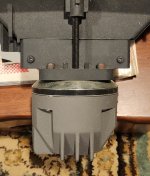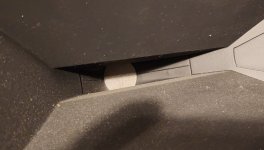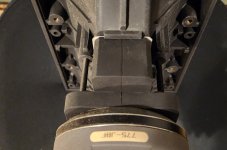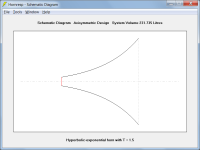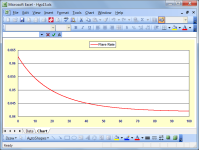@prairieboyAs a woodworker I've thought of making my own horns but realized that it really was a shot in the dark as to what would work and have resisted.
I would recommend simply buying some plans ( from the just mentioned Joseph Crowe ). His horn plans seem to be quite affordable.
Also, if I read through his blog-site correctly, he'll slightly modify the flare rate in the plans ( for any of his horns ) to better match up to that of the chosen compression driver ( he'll need "hands-on for that driver to optimize the response of the combo ).
That sort of service negates worrying about virtually everything being talked about here.
🙂
Last edited:
@Lynn Olson Interesting driver (ROSSO-65CDN-T). Nice measurements indeed. Diaphragm diameter 65 mm is intriguingly close to Yammi JA6681 (66 mm). Much cheaper than even the 3 inch diaphragm Be drivers indeed. For the price I would be curious...
By comparison, the value-priced ($200) SB Audience 1.4" exit compression driver is surprisingly good ... and does not behave like most titanium-diaphragm drivers, with first breakup raised to 17 kHz. (For those new to the discussion, this is close to beryllium-level performance at one-tenth the price.)
I've watched that video a few times and have almost bought a pair of those drivers just to check them out ( Josephs testimonials on it are quite convincing ).
- They are 50% more expensive up here in Canada though.
Of course, I need more drivers like a hole-in-the-head, but I'm open to eventually replacing my 30lb Altecs.
Note the lowish Fs of the driver.
🙂
Greetings all,
I do not want to undermine the discussion, but I has not been able to discern from the discussion what does the term "matching" or the driver and the horn "work[ing] well together" describe. Is the term "match" refer to optimization/improvement/enhancement of loading, pass-band, dispersion, reflections, or any other property of the horn?
In other words, how is the "match" to be evaluated?
Kindest regards,
M
I do not want to undermine the discussion, but I has not been able to discern from the discussion what does the term "matching" or the driver and the horn "work[ing] well together" describe. Is the term "match" refer to optimization/improvement/enhancement of loading, pass-band, dispersion, reflections, or any other property of the horn?
In other words, how is the "match" to be evaluated?
Kindest regards,
M
It has an conical exit angle of 18.36 degrees - would this make it harder to find a matching horn?I've watched that video a few times and have almost bought a pair of those drivers just to check them out ( Josephs testimonials on it are quite convincing ).
- They are 50% more expensive up here in Canada though.
Of course, I need more drivers like a hole-in-the-head, but I'm open to eventually replacing my 30lb Altecs.
Note the lowish Fs of the driver.
🙂
One of SBs other offerings the SB audience bianco 75cd-T 1.4" compression driver (https://www.sbaudience.com/index.php/products/compression-drivers/bianco-75cd-t/) has a conical exit of 6.16 degrees.
Just curious as to how this affects horn choice, buying decisions, etc - but I guess that is sort of the point of this thread. Just looking for thoughts or maybe it doesn't mean much.
mabat has made some interesting measurements in an attempt to see the difference in response across the exit at different points. There are clear differences between drivers that have 0 degree exits (HF1440) without adaption and those that aim for a spherical wavefront like the CDX-1425. Long conical adapters tend towards a similar response as the intentionally spherical. There are quite a few examples in and around the pages linked below.We're neglecting another factor at play here: the small conical driver exit throat makes the wavefront less flat and a bit more spherical (I think: am I right?) I assume this is negligible and not used by horn designers, but does anyone know?
https://www.diyaudio.com/community/...-design-the-easy-way-ath4.338806/post-7303252
https://www.diyaudio.com/community/...-design-the-easy-way-ath4.338806/post-7304652
In other words, how is the "match" to be evaluated?
Pano ( I thought ) pretty clearly established why this thread came into being , all within his first few posts.
Recapping; Kevin discovered less than ideal FR from his Yuichi 290 when it was mated to a Radial 950pb AL driver.
So my assumption is that we are mostly looking at smoothness of Frequency Response.
🙂
I don't know the answer that question.It has an conical exit angle of 18.36 degrees - would this make it harder to find a matching horn?
🙂
Hi EarlK,
But, after re-reading the thread based on your comment, I agree that this appears to be Pano's concern, cf., post #2.
Mea culpa, sorry for the interruption, carry on.
Kindest regards,
M
Actually, the thread came into being because Cask05 challenged Pano's claim that "horn [Yuichi] was designed for those drivers [TAD 4002, JBL2440]." Cf., Best Compression Drivers today 2022?, posts # 615, 623, and 626. Thus, I though that this would be more than an interest in "ideal", whatever the term means, on-axis frequency response.Pano ( I thought ) pretty clearly established why this thread came into being , all within his first few posts.
But, after re-reading the thread based on your comment, I agree that this appears to be Pano's concern, cf., post #2.
Mea culpa, sorry for the interruption, carry on.
Kindest regards,
M
I suspect it might not be ideal for the Yuichi A290 ... but in Joseph's words, his own ES290 wood horn is an updated derivative of the Yuichi A290, so maybe less of a gamble than it might appear.
The SB Audience 1.4" exit driver either has a very unusual phase plug or maybe the titanium is actually nitrided and SB isn't making a big deal about it. The 17 kHz first resonance is way above the usual first resonance for a titanium or aluminum diaphragm of that size (although 65mm is a little smaller than the most common 3" size).
There seems to be something odd about the big Radian driver, and the 1.6 kHz suckout that started this thread sure seems to be at low frequency. That's a big half-wavelength. But the question of the "adaptor", sadly misnamed since it is a critical part of the horn, remains. What is the best interface between XYZ compression driver and ABC horn, particularly for composite, non-axisymmetric horns like the Yuichi? For that matter, what about multicells? Rather than give up on them, what's the best interface?
The SB Audience 1.4" exit driver either has a very unusual phase plug or maybe the titanium is actually nitrided and SB isn't making a big deal about it. The 17 kHz first resonance is way above the usual first resonance for a titanium or aluminum diaphragm of that size (although 65mm is a little smaller than the most common 3" size).
There seems to be something odd about the big Radian driver, and the 1.6 kHz suckout that started this thread sure seems to be at low frequency. That's a big half-wavelength. But the question of the "adaptor", sadly misnamed since it is a critical part of the horn, remains. What is the best interface between XYZ compression driver and ABC horn, particularly for composite, non-axisymmetric horns like the Yuichi? For that matter, what about multicells? Rather than give up on them, what's the best interface?
Last edited:
I did look at Crowe's horn plans, and communicated with him, but his plans won't 'work' on my 2D Cad program.@prairieboy
I would recommend simply buying some plans ( from the just mentioned Joseph Crowe ). His horn plans seem to be quite affordable.
Also, if I read through his blog-site correctly, he'll slightly modify the flare rate in the plans ( for any of his horns ) to better match up to that of the chosen compression driver ( he'll need "hands-on for that driver to optimize the response of the combo ).
That sort of service negates worrying about virtually everything being talked about here.
🙂
Were those prices from Solen?I've watched that video a few times and have almost bought a pair of those drivers just to check them out ( Josephs testimonials on it are quite convincing ).
- They are 50% more expensive up here in Canada though.
Of course, I need more drivers like a hole-in-the-head, but I'm open to eventually replacing my 30lb Altecs.
Note the lowish Fs of the driver.
🙂
That just pushed me to get it posted faster. 😉 I had already been in long discussions with Kevin, Dave, AllenB about the subject due to Kevin's mismatch with the Radains. There are hints of driver matching sprinkled throughout DiyAudio, but I've never seen a clear explanation here or elsewhere. Thanks for asking because I'm curious what a "good match" is and how that would be determined ahead of time. AFAIK now, that would be FR both on and off axis along with a clean decay. To be explored.Actually, the thread came into being because Cask05 challenged Pano's claim
This is well put! How does one select a driver and an adapter to fit a rectangular entrance horn?
Given the knowledge, computers and 3D printers we now have, I think there is an opportunity to design very good adapters. Better ones than could have been designed back then. Hey, our adapters can even be tailored to fit specific driver and horn pairs.
It depends on how the horn is made. With JBL's like the Arrays, 9800, 9900 and the Everest's they are 3 piece casts. The throats and mounting plate are 2 halves and the balance of the horn one piece. The cross-section of the throat where it meets the horn is a rectangle so the transition from a round 1.5 round all takes place there. That's one way in can be done. You could print or machine.
Rob 🙂
Attachments
Nor am I quite sure. It's a term I see mentioned here and other places, along with "flare rate." A conical horn or conical driver throat has a linear expansion, although the rate at which the area increases, or expands, will depend on the angle of the cone. But other horns profiles have a changing flare or expansion rate (if those two things are different), they tend to expand more rapidly closer to the horn mouth.Not sure what you mean by driver expansion rate?
Hi Pano,
Please, do not misunderstand, I am by no means belittling the effort and/or your choice of the required properties, in fact, just the opposite, I am just trying to understand how is the "good matching" defined and and how will it be judged.
Kindest regards,
M
Sorry for another, perhaps again uneducated remark, but, the list of properties has a built-in assumption that these matter. But, there may be other preferences, e.g., some want loading of the driver by the horn, and a good directivity pattern; others do not care about loading; yet others prefer acoustic equalization, etc. Furthermore, some of the properties are perhaps orthogonal to each other.I'm curious what a "good match" is and how that would be determined ahead of time. AFAIK now, that would be FR both on and off axis along with a clean decay.
Please, do not misunderstand, I am by no means belittling the effort and/or your choice of the required properties, in fact, just the opposite, I am just trying to understand how is the "good matching" defined and and how will it be judged.
Kindest regards,
M
Exactly my point. 👍
The statement "In hypex horns, m increases monotonically from throat to mouth." (where m = flare rate) does not apply to hyperbolic-exponential horns that have a T flare parameter value greater than 1.
Attachments
Alas the hypex equation contains a transcendantal function of F12 meaning that F12 can not be isolated in a closed form expression and must be searched iteratively.
Not sure that I understand. Given S1, Sx, x and T it is possible to directly calculate F12.
halfAngle(x) = atan( [ sqrt(Sx+eps / pi) - sqrt(Sx / pi) ] / eps)
where
x is distance and set to 0 for finding the angle at the entrance of the driver
eps is some arbitrary but very small distance
Sx+eps and Sx are the hypex areas calculated at distance x+eps and x
Using calculus it is possible to derive an exact solution for the hypex half-angle:
Ax = Atan(R1 / 2 * (m * (1 + T) * Exp(m * x) - m * (1 - T) * Exp(-m * x)))
Where:
Ax = half-angle at distance x from throat
R1 = throat radius
m = flare constant
T = flare parameter
At the horn throat (x = 0) the above expression simplifies to:
Ax = Atan(R1 * m * T)
I did this simplistic horizontal one which demonstrates finding the right curvature. I should also do some verticals showing how curvature there could be a problem.Wouldnt it be cool if there was a visualization - like this one - of what happens when there's an angular mismatch between the horn and adapter?
Here vanes have been set radially as shown (click to enlarge)..

A flat wavefront would not be ideal..
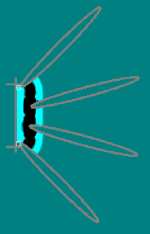
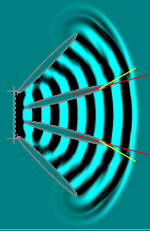
Compare this to a rounded wavefront..
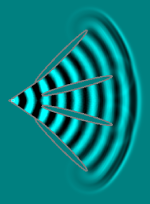
Passive methods are not a limitation to fixing all that needs to be fixed. Knowing what to fix and how to do it will be. Not everything that looks less than ideal should be touched, or at least flattened. Ironically, DSP makes it too easy to overdo it 😉has similar limitations as a passive xover
- Home
- Loudspeakers
- Multi-Way
- Matching horns to compression drivers, a discussion
